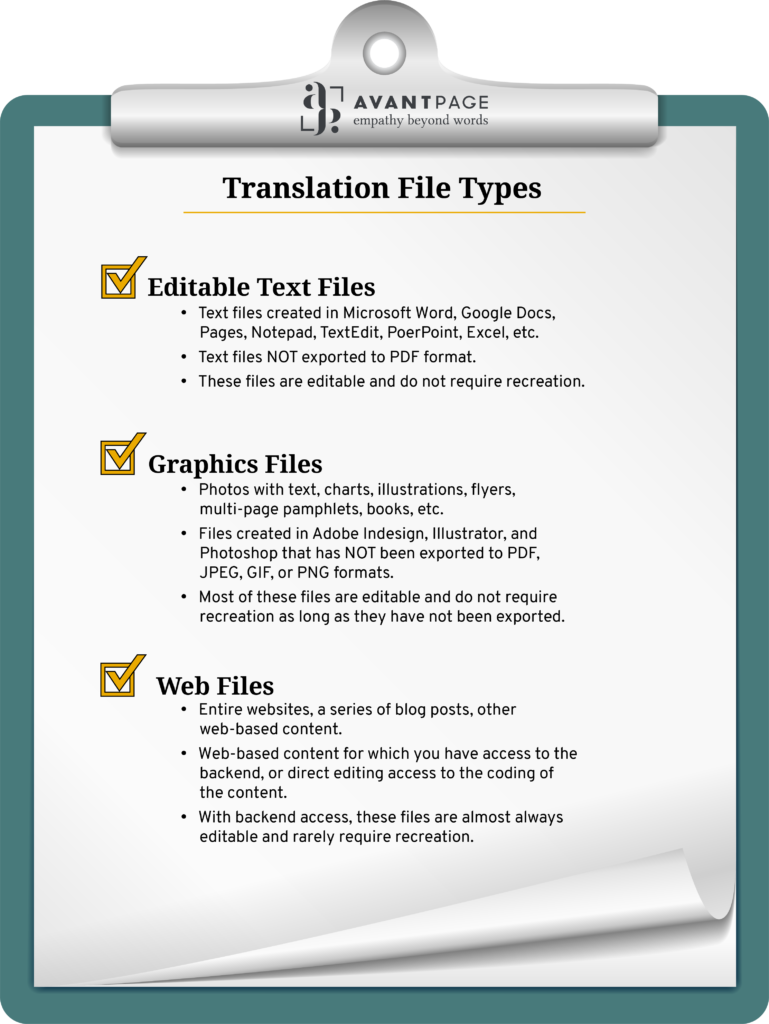The Quick Guide to the Best Translation File Types
At Avantpage, we can translate documents into more than 150 languages, but that work is a lot easier if we receive one of our preferred translation file types.
What’s a preferred translation file type? Simply put, it’s an editable document that we can place a cursor in and click around and delete or add words. When we work with these translation file types, our team can work faster because they don’t have to recreate the document. Here’s a quick guide to some of the common translation file types we receive and how they affect our workflow.
Translation File Types: Editable Text Files
Text files are usually created in a program such as Microsoft Word, Google Docs, Pages, Notepad or TextEdit. Presentations created in PowerPoint or spreadsheets created in Excel would also fall into this category. These files are generally pretty easy to use for translation. It’s especially important to send us the original file of your document if it includes images or complicated charts, as this will allow us to edit the element directly. One quick note though—exporting or copy and pasting a PDF file back into a text document can often introduce errors or formatting issues that may require recreation.
- Common Extensions: .doc, .docx, .dot, .dotx, .docm, .dotm, .rtf, .txt, .ppt, .pptx, .pot, .potx, .pptm, .potm, .xls, .xlsx, .xlt, .xltx, .xlsm, .xltm
- Editable: Yes
- Requires Recreation: Usually no
Translation File Types: Graphics Files
Graphics files are well, graphical! These translation file types include a photo with text on it, a chart, an illustration, a flyer, a multi-page pamphlet or even a book. The most important thing to know about these types of files is that sending an editable one for translation will not require recreation. For example, if you send an Adobe Indesign (.indd, .imdl), Adobe Illustrator (.ai) or Adobe Photoshop document (.psd), we can edit that file directly and create your translation. However, if you send a file that’s “frozen” such as a picture (.jpg, .gif, .png, or .tif) or PDF (.pdf), our team at Avantpage will not be able to edit the document and will need to recreate it. While recreation can be an additional expense, the beauty of having it recreated is that you can update the document or translate it into another language very easily.
- Common Extensions: .ai, .gif, .imdl, .indd, .jpg, .pdf, .png, .psd, .tif
- Editable: Sometimes, check by file type
- Requires Recreation: Sometimes, check by file type
Translation File Types: Web Files
If you need to translate an entire website, a series of blog posts or another type of web-based content, you may think that you need to copy and paste all of it into an editable text document. However, we have an easier way! At Avantpage, we can work on the backend of a website directly in the code. This can ensure additional accuracy and clarity for your project.
- Common Extensions: .htm, .html, .xml, .xhtm, .xhtml
- Editable: Almost Always
- Requires Recreation: Rarely
While some of this language and acronyms can be very technical and specific, sending easy to work with translation file types ensures that your project can be done quickly and within budget.

Translation File Types Checklist
At Avantpage our experienced team can help guide you through the translation process and make it fast and easy—no matter the file type. To find out more about our services or to get a free quote, email us at [email protected] or call us at 1-530-750-2040, extension 11.